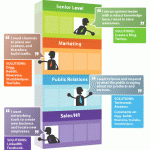
I was recently interviewed by Gulf Business for their Digital Issue – below the transcript of my questions, the full pdf file can be downloaded here.
Q: Which sectors are on the rise (digital marketing, mobile apps, mobile marketing etc.)?
The Middle East as a region has suffered due to the economic downturn in terms of advancement during 2009/2010 – but will catch up very quickly. Digital marketing really covers all marketing today, so many channels and media have taken on a digital spin be it live outdoor with Bluetooth, or magazine ads on the iPad.
Looking specifically at what we might traditionally call ‘digital channels’ here, display (banner) advertising is in full swing but there is a great deal of clutter – the region needs to start improving the quality of the creative and develop more of an interactive/engagement mentality, as you can see from much of Leo Burnett’s work, we try to avoid very simple banner ads that get lost in the sea of online and develop work that either serves a purpose (GM in-market search programme) or adds value, utility or fun to the online experience (Kellogg’s banner games for the launch of Tresor). Search is probably under-utilised the world over (not just in the Middle East) and this is an area that has great potential, but it starts to get very technical when we look at what can be done either through targeting or post-view analysis – there are great opportunities here and media agencies will reap the rewards.
In the next five years there are approximately 17 million users coming online in the region and many of these will not access the web using a traditional PC. With the growing use of smartphones, mobile apps and mobile marketing in general are a growing market – but with the advent of html5 we will also see a movement away from native apps (which are painful to develop on multiple platforms) towards web based experiences that can be delivered through the phone.
Another growth area we are starting to see waking up in the Middle East is gaming – over 38% of online gamers worldwide are located in the region and this can be an enormous platform from which to start, Egypt and KSA in particular have massive populations. As brands start to connect gaming and marketing there will be an explosion of investment in this, today niche, sector.
Regardless of the changes in media channels, and the advent of new channels, the real opportunities for marketing and communications are in synchronized communications where channels are chosen for what they can contribute to an overall messaging strategy.
Q: Is variable and low internet penetration a key issue holding progress back? Is it improving?
Internet penetration is much higher than we really imagine, and this is particularly going to be driven by new ways to connect. Changes are going to happen overnight, particularly in markets that are still heavily controlled by monopoly operators (rumours of upgrade to 3G mobile broadband in Lebanon are abound). Gone are the days when you needed a fixed line at home and a computer tied up to it. Today we have wifi and wimax and a number of new devices – not least of which the smartphone – to get connected.
I think we will soon see a massive jump in penetration as smartphones become available to the masses and the operators see competition in the data plan market.
Progress is not really being held back as we will always be challenged (and constrained) by the type of hardware that exists in the market – however quickly chipsets speed up, or new screens appear, the user cannot update their equipment on a regular basis – it is now about the intelligent use of technology; a good regional example of this is STC who launched a java (Nokia) based version of the Facebook application since they realized that a large portion of their installed base was on this sort of device and hence even with low data consumption this is an untapped market.
Leo Burnett has recently launched two major online activities for consumer goods products – one a set of 3D games aimed at younger children and the second a competition for users to upload and share content – the success across the region is outstanding, so internet penetration may not be really holding us back, when users want to get online they’ll find a way.
Q: Does censorship discourage innovation?
I don’t see why it should, on the contrary it encourages it, life is full of constraints, be they about what we can do, how we can do it, or even with whom. Innovation is sometimes about creating something new within a set of parameters (see the STC-Nokia-Facebook example). Alcohol and tobacco marketing (Leo Burnett works with both types of clients on multiple channels across the region) the world over is heavily controlled but this doesn’t stop some of the most creative marketers from developing one-to-one programmes that can communicate with consumers.
What is more difficult in the region is the understanding of what censorship covers and its shifting boundaries; countries can shut off the internet overnight if they choose, or block certain sites like Facebook for no real reason – this is what marketers feel to a certain extent that these are risky investments, as there is more clarity, there will be more growth and innovation.
Q: How is social networking affecting consumer behaviour?
This question seems a little ‘over asked’ in my opinion and we are seeing the changes in consumer behaviour everyday. Social networking ultimately minimizes information arbitrage, sharing information and comparing products and services, the power of connecting people is changing the way that we interact and also make decisions, not only this but it is also changing the impact that media and advertising can have on forming opinions. 10 years ago you had to believe the ads or try it yourself, today whatever the product there is a good chance that you can connect with someone to give you a tried and true review before buying anything.
In the region, the information inbalance is more painfully apparent as media and information is still extremely controlled by the hands of a few; once people have access to information and each other, the barriers to connect are low, we see what happened with all the protestors and activists. This will probably have to go on for a while before consumers move over to prioritizing corporate messages – and hence let a brand build “equity” through social networking.
Q: How are consumer habits changing?
Apart from how we make decisions and have access to information, consumers are potentially exposed to more choice in every decision they make – and as Barry Schwartz in his book The Paradox of Choice there may well be a decreasing rate of return for consumers as they get more options.
Alongside this, privacy is changing meaning, tomorrow’s generation will not be worried about what they put on Facebook or LinkedIn, it will be normal that the world can have a window onto their lives – how this will affect employment and opinions is another matter.
Q: How is social networking affecting corporate behaviour?
Social networking is affecting corpprate behaviour at a number of different levels:
For marketing it has created a number of new channels or touchpoints with the consumers and a constantly evolving space in which to curate the brand’s reputation.
For customer services it also opens up media for a two way dialogue with the consumer, but also a conversation that can be overheard by other consumers and also prospects.
The Elliance infographic ‘Building a Company with Social Media’ is a great example of this.
Q: Can businesses afford not to be on twitter (and similar sites)?
Today if you are managing a brand then you need to be managing its reputation everywhere – this means not only the product and communication, but all media where it appears and this most definitely includes social media. If you aren’t in control of your brand on Twitter then the chances are that someone else is managing it for you – and this doesn’t always lead to positive results.
If conversations are going on about a brand then the brand should have a voice as part of the dialogue.
This being said, there are brands that have (until now) avoided the social media scene – the most evident of these is Apple, who have no official social media presence and hence could be said to not interact with their audience. The power of Apple is the fact that they have so many fans the world over that social media presence is created and maintained by this user base who act as ambassadors for the brand – alongside this, Apple’s ‘controlled’ release of information is a fine art, and even without these channels of communication they can always get the word out.
Q: How can companies use twitter (and similar sites) effectively?
Social media does not have a single application within the organization – and this can create operational complexities since it is unclear who should be managing a brand’s social media presence.
- Research & product development: Here connection with consumers can give realtime insight into their opinions and get feedback on needs and attitudes.
- Marketing: Driving a message about new product launches, sales or promotions directly into a conversation, when done correctly, can have a much greater impact than traditional media.
- Customer service: When issues arise within social media, customer service are best placed to respond so that they can resolve the complaint and deliver a ‘good story’ for all consumers to see.
